The use of the 4-2-3-1 out of possession has gained popularity in recent years with various teams using different systems within this shape. Within any pressing shape, variations can be gained by adjusting the roles of players within the press and the intentions of their movements while pressing. Having previously written about the 3-4-3 in this regard, this tactical analysis will focus on the 4-2-3-1 and the many variations seen from teams who press from out of this shape. I will look at the relative advantages and disadvantages of each scheme, as well as examining the flexibility of the formation as a whole.
As a disclaimer, looking at pressing variations is a difficult topic, simply because the formation of a 4-2-3-1 is itself just a variation of a 4-3-3. As a result, in terms of pressing variations, we will be looking at the variations of teams that use the 4-2-3-1 as a base/starting formation.
Why is the 4-2-3-1 so popular?
The rise of the 4-2-3-1 formation likely comes in part from the increasing use of a 4-3-3 with a single pivot when in possession. The 4-2-3-1 naturally matches up against this formation, particularly in its midfield staggering, with an attacking midfielder obviously taking up a similar space as an opposition holding midfielder. We can see the most obvious 4-2-3-1 pressing structure against a 4-3-3 below. The striker is tasked with pressing the two centre backs, while the wingers usually protect the central areas and half-space initially, before then being triggered to press the full-back in a wide area. The pressing ten (attacking midfielder), can man-mark the pivot, while the two holding midfielders can also match up man for man with the other two opposition central midfielders. Without a forward dropping or a defender moving forward, a 4-3-3 finds it difficult to create numerical superiority against a 4-2-3-1.
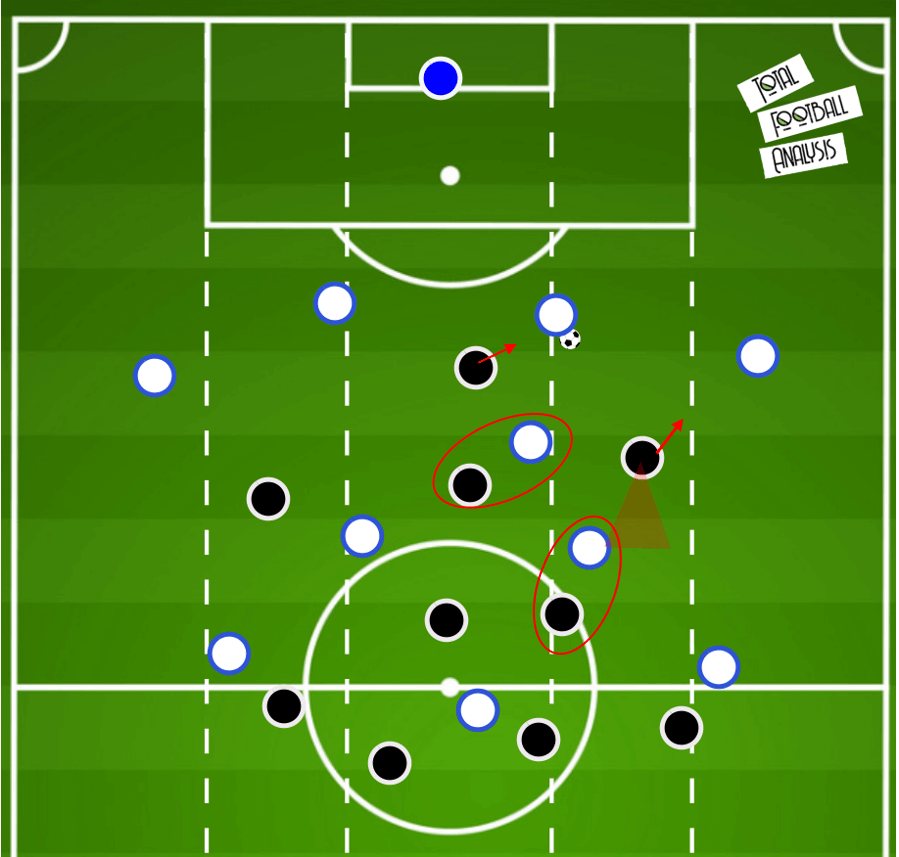
Dealing with the 2v1
One of the important factors if pressing high in a 4-2-3-1 is maintaining constant pressure on the centre backs. If you use a variation of the 4-2-3-1 which involves one striker pressing two centre backs, this can be difficult, as switches between each centre back make it difficult for constant pressure on the ball. As a result, teams have to find strategies to combat this, and below is an example which can be used.
The slightly adjusted pressing structure aims to cut off the ball near side of the pitch in order to force a switch across to the other centre back. We see the winger now starts slightly wider and gets closer to his full-back in order to deter the centre back from playing into him. Because this winger moves wider, increased occupation of the half-space is needed, and so as well as a holding midfielder marking an opposition central midfielder, the pressing ten can also focus more zonally and occupy this space. The striker drops deeper and looks to keep the pivot in his cover shadow. As a result, all the ball near options are cut off and the obvious pass to the opposite centre back is played.
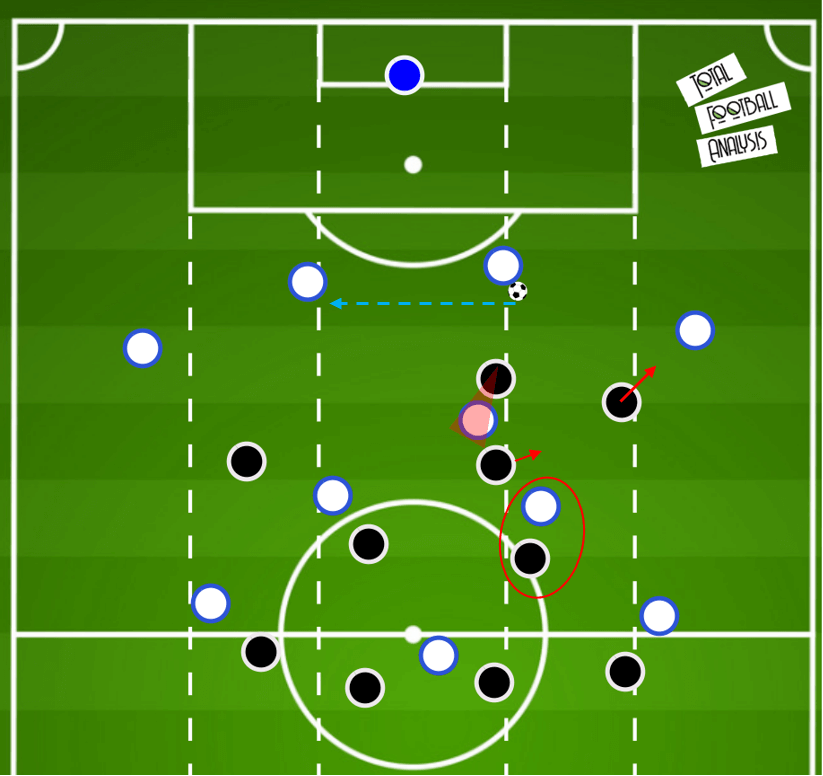
We can see once the ball is played this acts as a trigger for the striker to press to make an arced run to cut off the passing lane from where the ball just came. As a result, pressure can be applied while cutting off one side of the pitch and restricting the opposition’s options. In response to this, the in possession team is likely to drop it’s ball near midfielder closer to the ball. The holding midfielder can then mark this player, while the ball far holding midfielder now has to get across to cover the space left behind this pressing midfielder. As a result, the formation is left in a 4-1-4-1 temporarily. We will discuss midfield staggering later in the article.
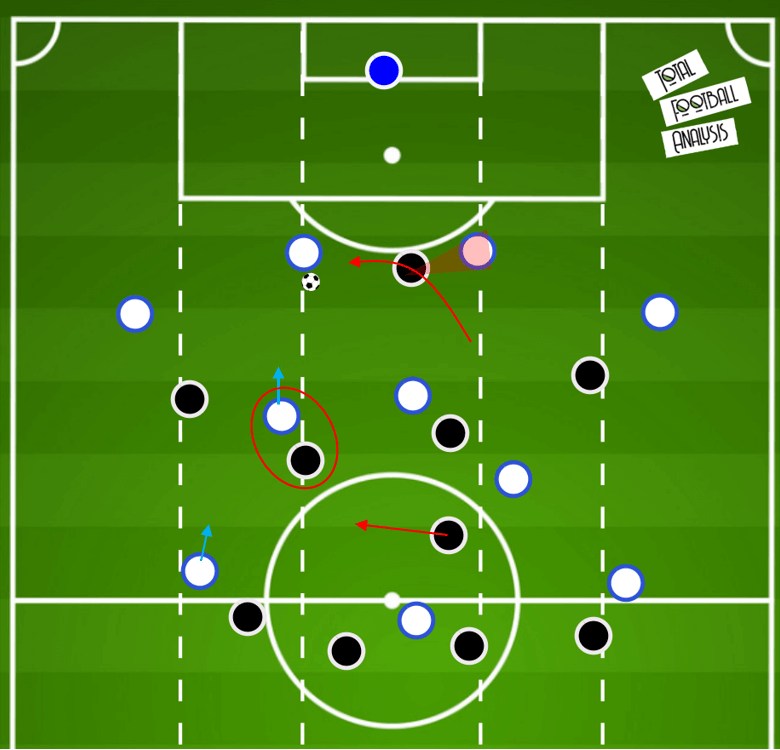
Another variation which can be used to maintain pressure on the backline is the use of the pressing ten as a second striker. Bayern Munich use this often and will commit Thomas Müller higher to press one centre back while Robert Lewandowksi presses the other. The central midfielders become fairly man-oriented against the opposition central midfielders, and so Bayern Munich often transition from their 4-2-3-1 into a 4-4-2 while out of possession.
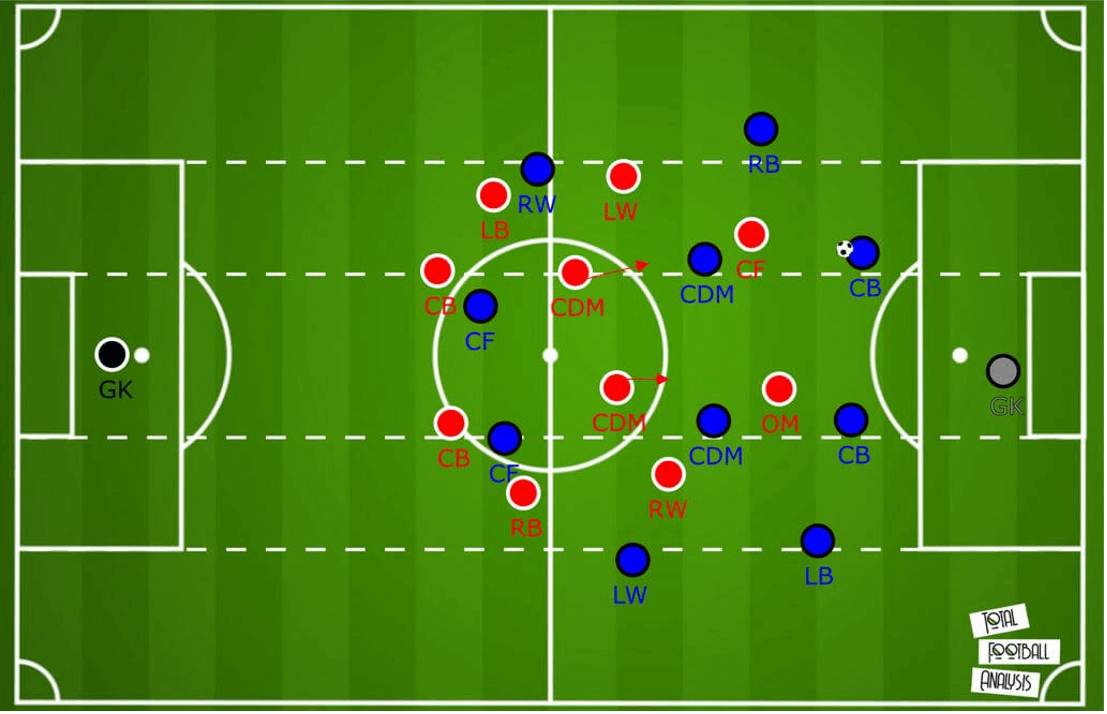
We can see an example of this pressing scheme below with Müller pressing a centre back and Bayern now in a 4-4-2. As we can see in the above example, this obviously matches up well against a 4-4-2 shape, but having only two central midfielders does open up the possibility for midfield overloads.
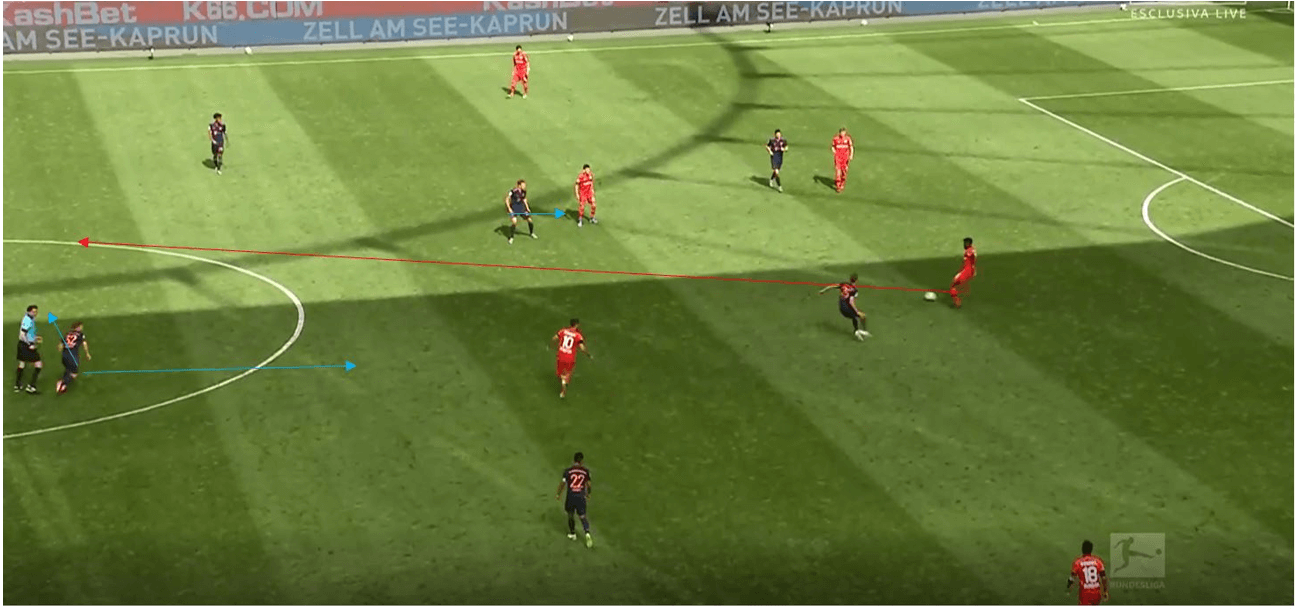
We can see here, for example, Borussia Dortmund are able to create an overload in a 3-4-3 against Bayern’s 4-4-2. Müller presses the centre backs and doesn’t focus on the pivot here, so a 3v2 is created in the midfield with a 2v1 created on Joshua Kimmich. This image allows us to imagine quite easily how if Müller does look to cut access to a deeper pivot, then Bayern can remain balanced and it becomes difficult to overload them. Compromising between this balance and constant pressure on the ball is one of the main overall conundrum’s while pressing in a 4-2-3-1.
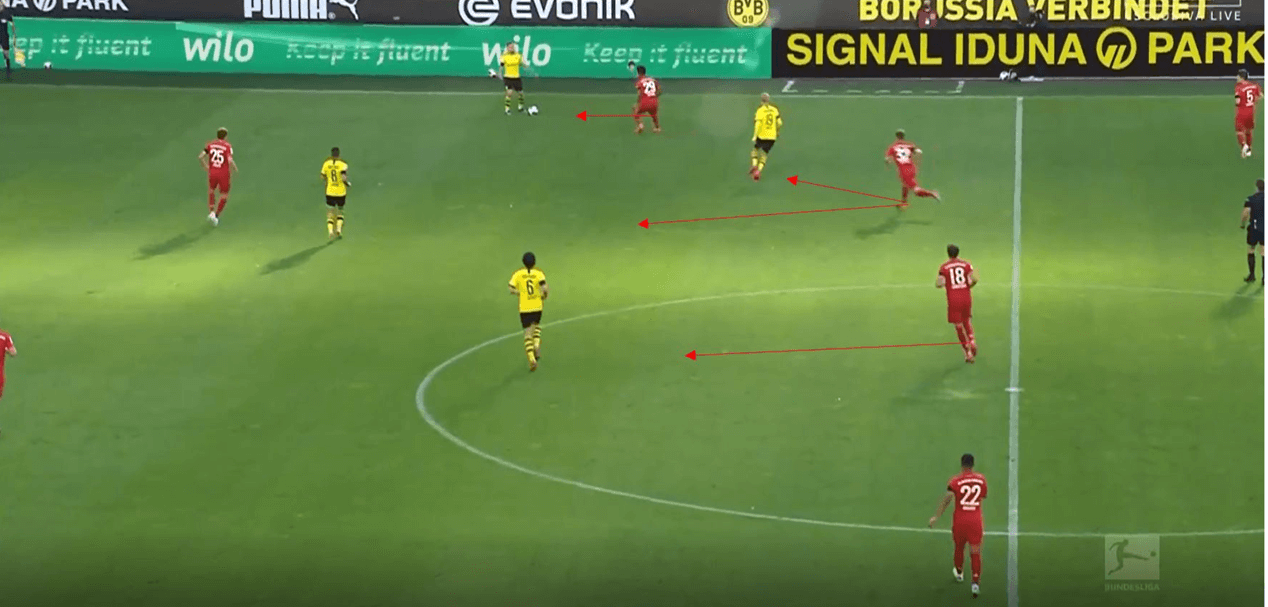
Showing the opposition centrally
In simplistic terms, when teams look to progress past an opponent, they can do so by playing through, around or over. On the flip side, as a defender or defensive unit, you can show the opposition central passes, wide passes or long passes. These options are what allow for variations on an individual level, although they have an impact on the whole team.
Carrying on from the idea of preventing overloads while also maintaining pressure on the centre backs, one useful variation involves the inside forwards pressing inwards while cutting the passing lane to the full-backs. The press is triggered by a switch from centre back to centre back, and so both the striker and an inside forward can apply pressure on the two centre backs. The pressing ten can stay deeper on the pivot and so the pressing team can maintain a three-man midfield, which is difficult to overload.
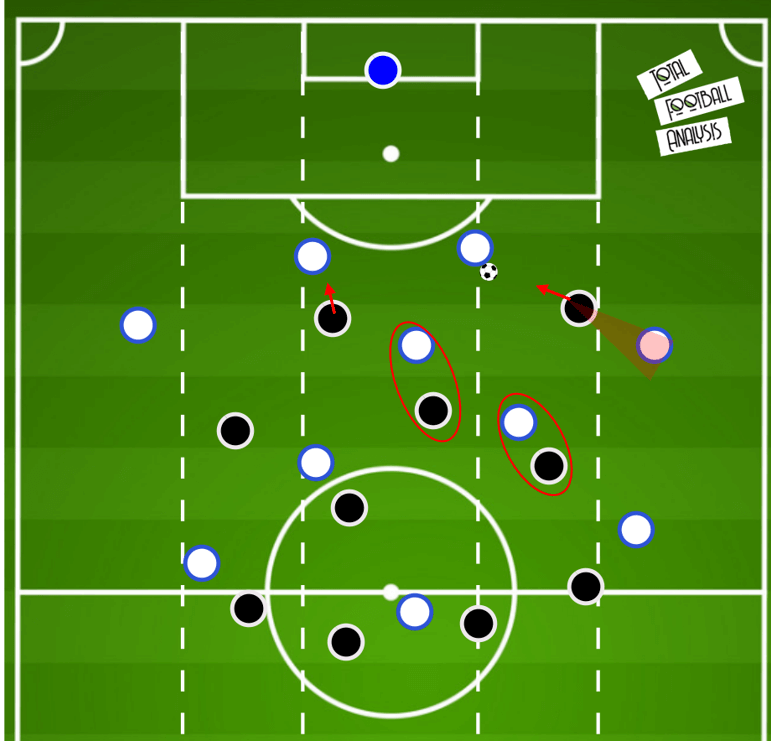
Another variation on this would be to have the number ten perform a dual role, with this player’s role now involving the player marking the pivot before then making a pressing run on the centre back while still covering the pivot in their cover shadow. You can then organise a pressing trap where you have pressure from two directions on the centre back. The midfield can remain balanced and is in a 3v3 if the pressing ten does their job. You could also allow the pressing ten to press the first centre back while keeping the pivot in their cover shadow.
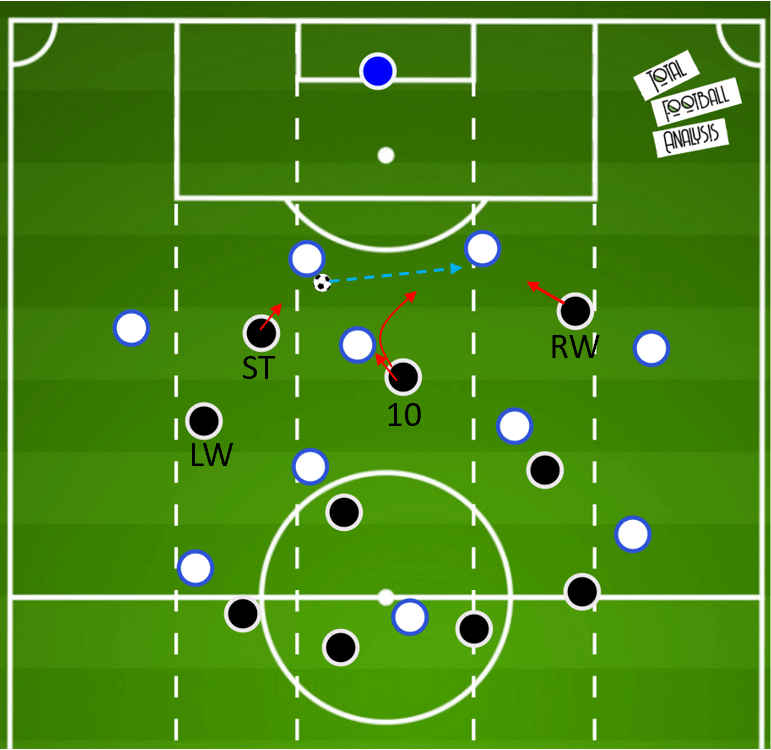
In deeper areas where a goalkeeper comes into play, the full-back can push higher to press a higher full-back, so, situationally, teams will adopt a back three at times, further proof that talking in terms of formation is fairly useless.
To go full Klopp, you could assign your striker the solitary role of covering the pivot, so you then rely solely on the wingers/inside forwards to press the centre backs while keeping the full-backs in their cover shadow. Your pressing ten would then have little reason to stay too high up the pitch unless the pivot became overloaded, at which point the central player would push higher and act as a pressing ten.
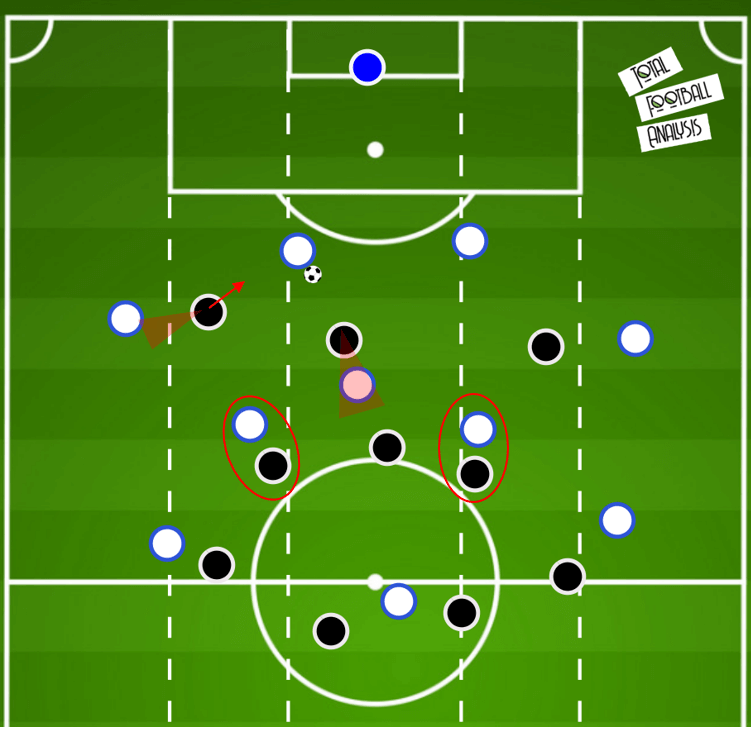
We can see Jordan Henderson situationally becomes a pressing ten in order to press a deeper pivot for Liverpool here against Manchester City before Mohamed Salah then makes that arced run to show City into a central area. The system Liverpool use is much more of a 4-3-3 as their system seeks to prevent having a high pressing ten often, but, situationally, it sometimes moves to a 4-2-3-1. Talking about the differences between the two is pointless as many different formations arise sporadically and situationally in a game. Looking at the intentions of the players is far more useful.
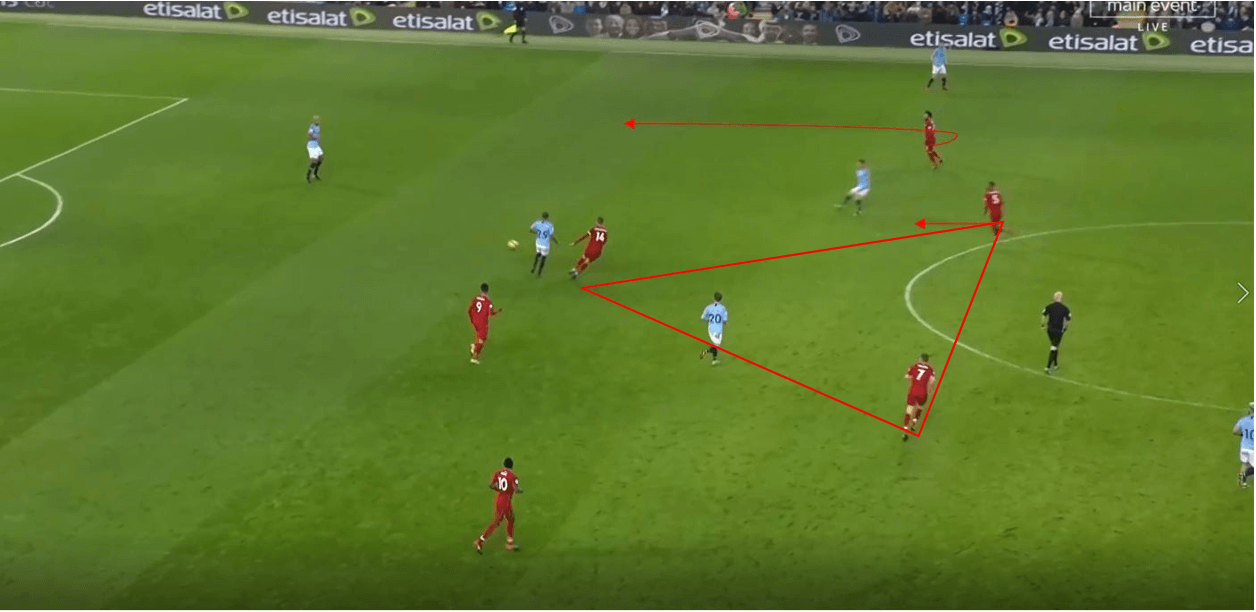
Showing the opposition wide
In contrast to leaving the centre open, the 4-2-3-1 structure can be used in order to cut off access centrally and, therefore, show the opposition into wide areas. Showing the opposition into a wide area generally means that there is less pressure on the ball and a more passive approach is taken, but teams can act on certain triggers to apply pressure to the ball.
We can see an example of Klopp’s Dortmund against Bayern Munich, with Klopp’s Dortmund side often using a more passive 4-2-3-1 here which falls back into a 4-4-1-1. The wingers sit deep to allow the full-backs space, while the striker and pressing ten cover the double pivot of Bayern Munich. Because the Dortmund central midfielders are not occupied, they can provide cover in front of the defence and the half-space and can mark higher midfielders or dropping forwards.
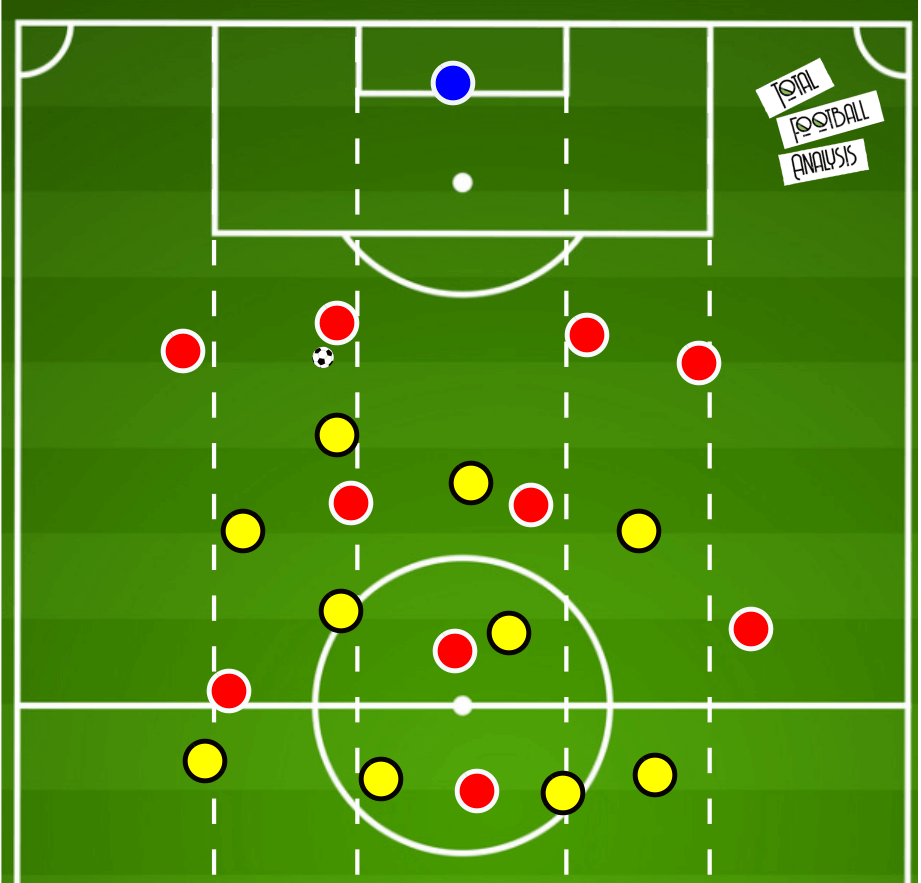
A pressing ten could be used almost as a zonal marker around the pivot space in order to prevent the deeper midfielders pressing high up the pitch, which therefore helps when the ball goes wide.
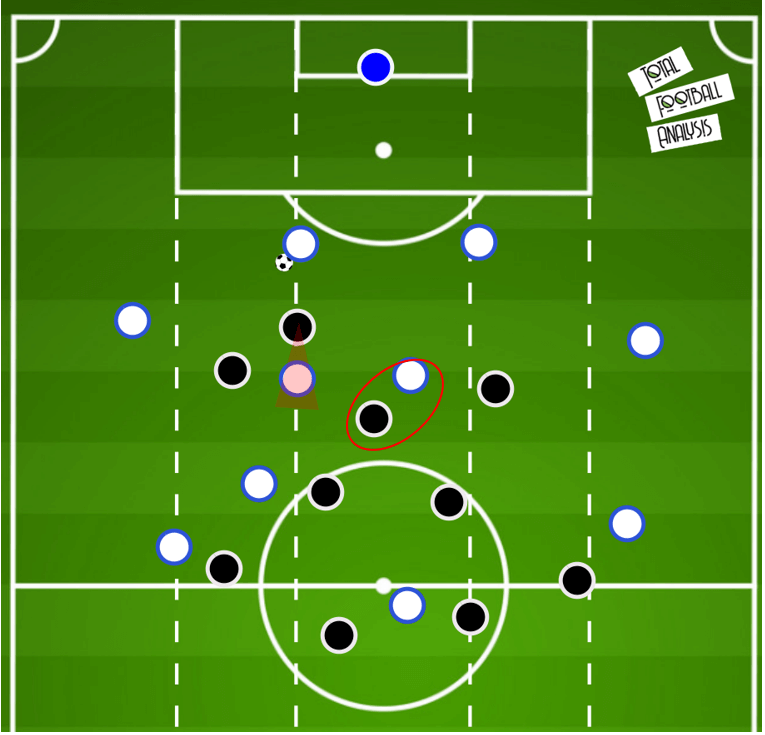
Once the ball goes wide, nearby options for the ball carrier can be cut off, as we can see below. Depending on your intentions as a team, you could have your pressing striker back press against the nearby pivot, which allows for your pressing ten to help cover higher opposition midfielders, which in turn then allows your deeper midfielders to cover the back four effectively. This approach is likely to force the opposition back often, and so a more aggressive approach would be for the pressing ten to simply mark the pivot.
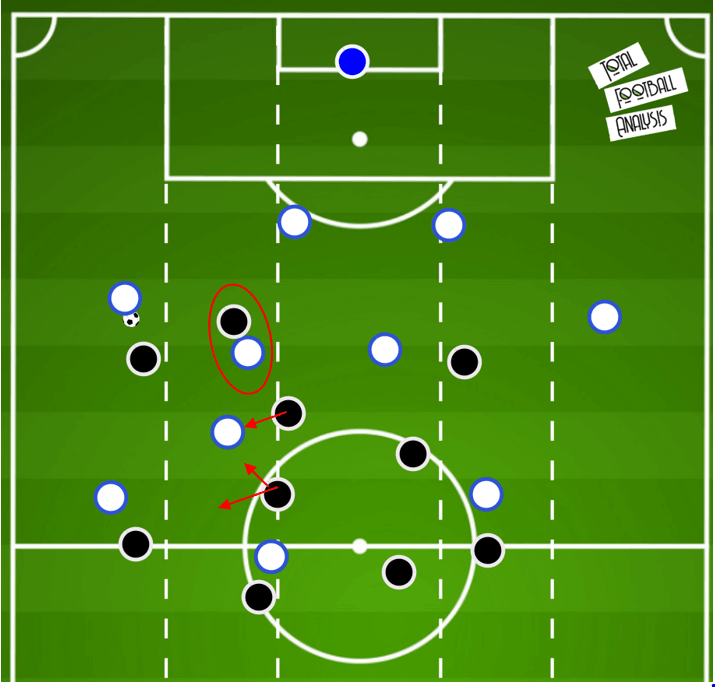
Showing the opposition long tends to involve high-intensity man marking all over the pitch, matching up to ensure constant pressure is on the ball and nearby passing options are covered is what is generally used to force teams long. We’ve already briefly covered that, so we won’t do a section on it. Each direction you show the opposition has its own advantages and disadvantages. Showing centrally is generally a high risk, high reward strategy, as recoveries in this area are generally ‘higher quality’ (lead to better ball progression) compared to recoveries in wide areas. Central areas allow better ball progression from recoveries, but they also allow for better ball progression for the in possession team, so it is generally harder to press players in this area. Wide areas allow for easier pressing, but with less rewards.
Back threes and diamonds
The examples so far have mainly focused on the 4-2-3-1 matching up against variations of the 4-3-3 and 4-4-2, so it is useful to look at how other formations can interact with the 4-2-3-1. The first formation we will look at it is the diamond and how its narrow four-man midfield can create overloads in midfield. We can see an example of the diamond being used here against a basic 4-2-3-1 set up. A pivot drops deeper and should be pressed by the pressing ten usually, however, this player is overloaded with players in front of them and to their right. As a result of this overload, the right-winger may tuck in, but if they tuck in too much, the switch to the left full-back opens up. The two eights in the diamond take up positions either side of the pressing ten, so, depending on the position of the ball, at least one of the holding midfielders in the pressing team is likely to have to move higher.
In this example, it is the left-sided midfielder who moves higher to press, however, again an overload can be created this time through the use of an attacking midfielder. The in possession team can experiment with angles in order to open up passing lanes to this open player, with optimal spacing between the six and eight required in order to open up that central lane. The use of a 4-2-2-2 would also be useful here to create such overloads.
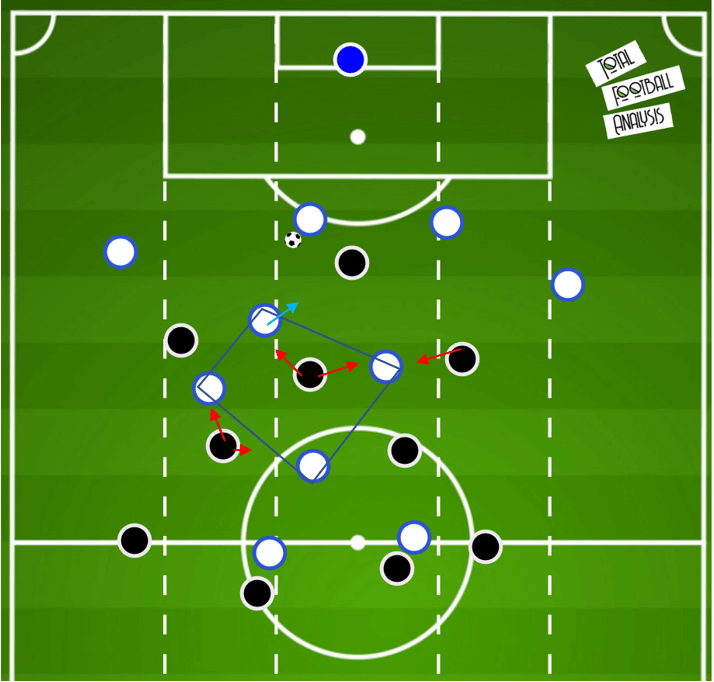
As a result of these overloads, from the pressing team’s point of view, it is vital that they find ways to temporarily create numerical equality or nullify these overloads where possible. We can see an example of this below, with the striker helping to nullify the overload by maintaining pressure on the ball while keeping the pivot in his cover shadow. As a result, the pressing ten can focus more on the player behind him and the pressing team can technically have a 4v4 overall.
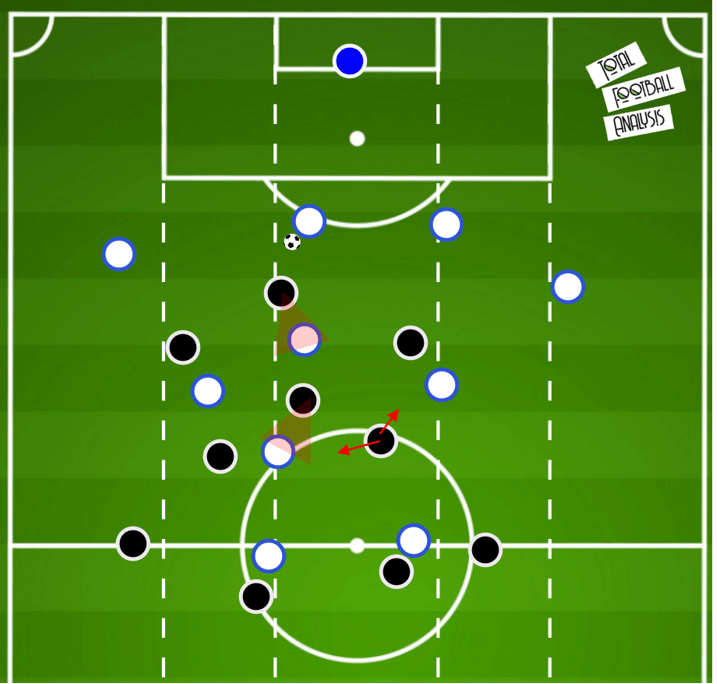
The use of a back three by the opposition makes it even more difficult for the pressing team to maintain pressure on the ball and, as a result, the team in possession can often find that their backline has more time on the ball. We can see an example below where if the nearest player rushes in to press while showing to the wing, the pressing team would be forced to commit a full-back higher. Teams can still remain stable in this structure, but for me, it isn’t the ideal scenario.
We can see in this example that the winger, therefore, stays deeper and protects the half-space, while the opposition central midfielders split to create a passing lane between the two very man-oriented pressing midfielders. If centre backs are left unpressured, they can often drive forward with the ball and look to trigger a press from the second line, which helps to create overloads.
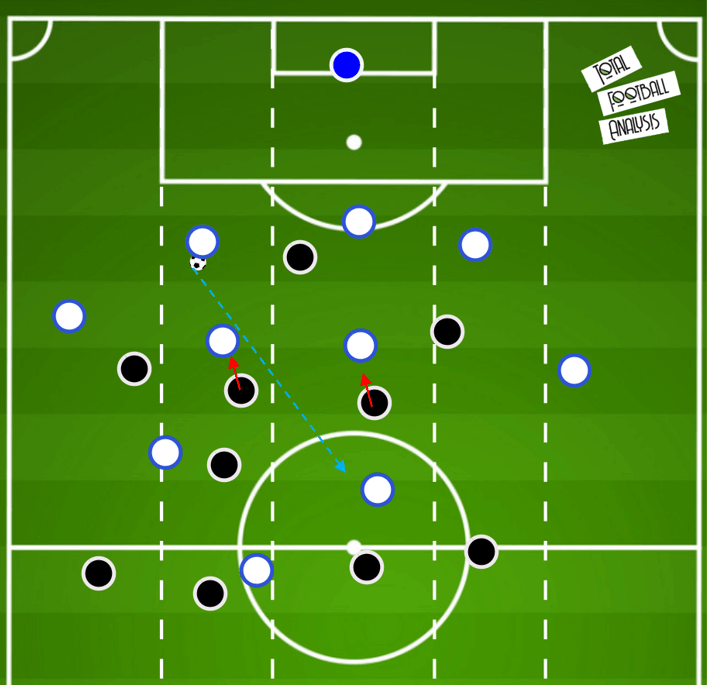
Teams will therefore look for ways to put pressure on the backline in order to force immediate turnovers. We can see an example below of Bayern Munich’s 4-2-3-1 press against Borussia Dortmund’s 3-4-3. If the one striker could force the ball in one direction to a wide centre back, the attacking midfielder would push forward to create a 4-4-2 for Bayern. The winger would sit deeper and protect the half-space and get in a position to press the wing-back, while Bayern’s two central midfielders could press Dortmund’s two central midfielders. Because the pressing ten had committed onto the backline as a striker, it was now a 2v2 in midfield, so when Julian Brandt (highlighted) dropped from Dortmund’s forward line, he could create a 3v2 overload in the midfield area.
Bayern opted to apply pressure on the ball rather than to nullify and cover overloads, and so Bayern’s midfielders had the role of managing these overloads, which they did excellently.
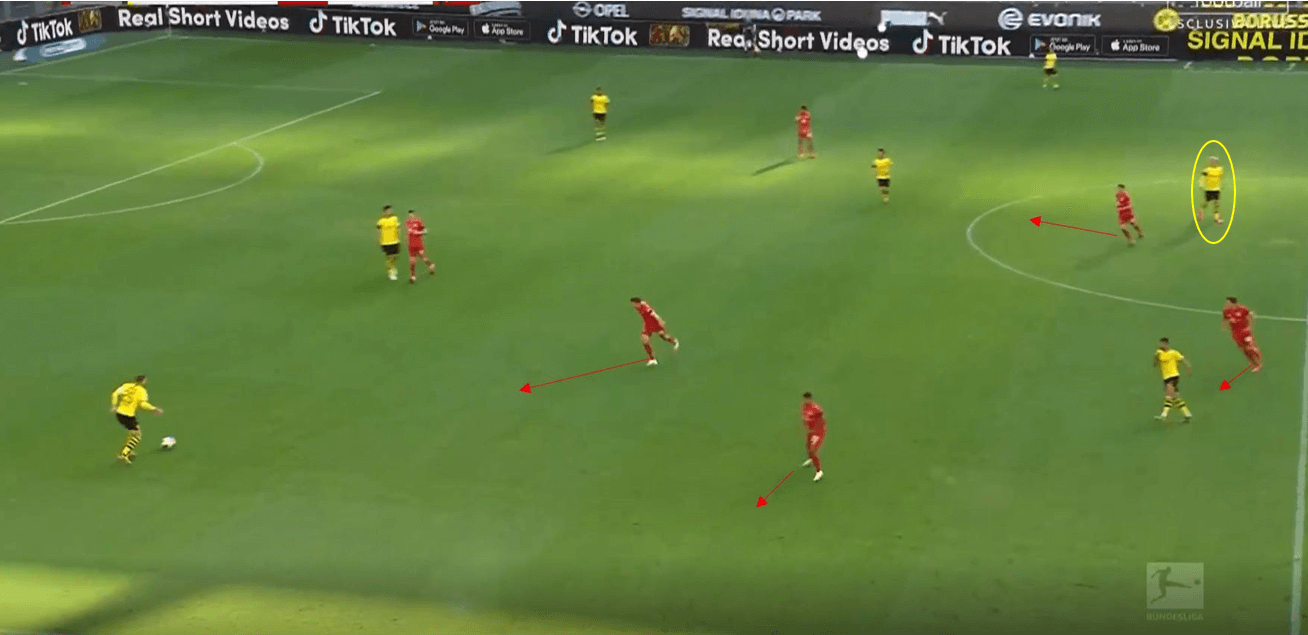
We can see an example of a back three creating more overloads here, with two central midfielders overloading the pressing ten. The depth of these players can cause problems for the deeper pressing midfielders within the 4-2-3-1 and, if offensive midfielders can be used in these areas, overloads can be created. We can see all of the potential possibilities highlighted below, with overloads able to be created no matter which player’s press which of the ball near pivot.
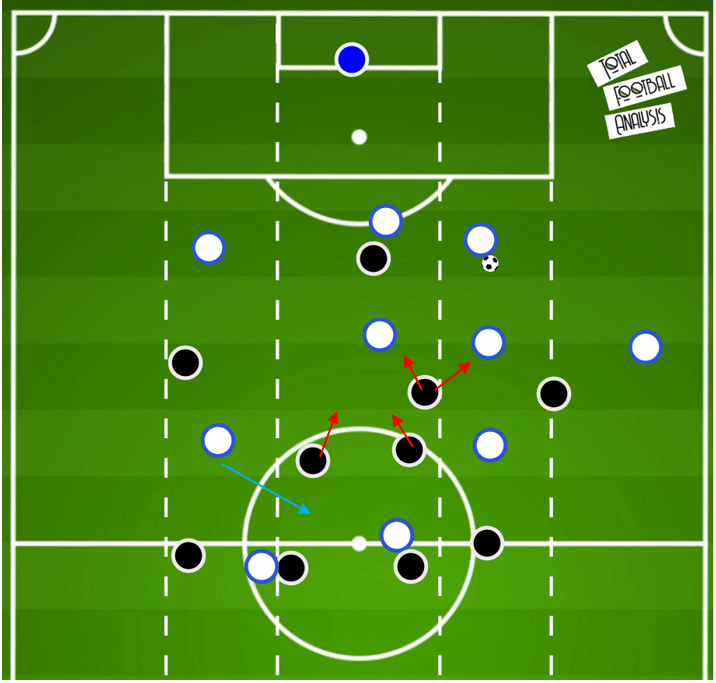
As we saw in previous variations against a back four, using the wingers to press inwards can often be a very useful strategy. We can see an example of this below against a 3-4-1-2, where this pressure from the winger allows for the pressing ten to commit to a midfielder, which helps to reduce the chance of overloads being created. Again, pressing triggers previously highlighted could be used here in order to lock the ball into one side of the pitch, which enables the best chance of maintaining pressure on the ball. The full-back is likely to push slightly higher here in anticipation of the opposition potentially working the ball wide.
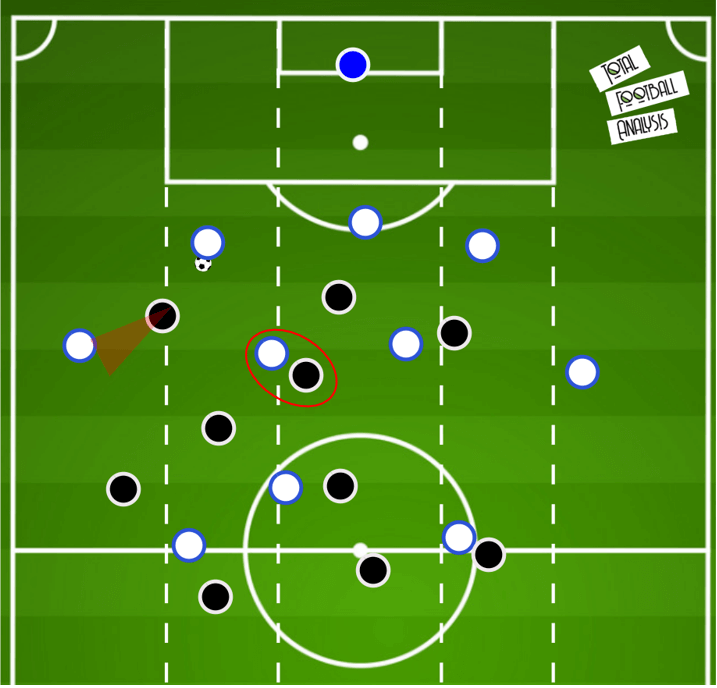
Conclusion
This tactical theory analysis has sought to explore some ideas around the 4-2-3-1 and why it can often be a useful pressing scheme due to its staggering in the midfield, which often helps to press against opposition pivots.
Like every formation, the 4-2-3-1 has advantages and disadvantages and the number of different roles each player can have allows for many variations of the formation. Usually, the 4-2-3-1 simply acts as the base formation for the side before they react situationally to the opposition’s movement. We see with teams like Bayern Munich, the press can move through a 4-1-4-1, to a 4-4-2 and a 4-3-3 depending on the situation. As I mentioned earlier in the article, it is the intentions and decision making of the players which determine variations within shapes and these decisions that are made collectively come together to form the ‘tactics’ of the team.





Comments